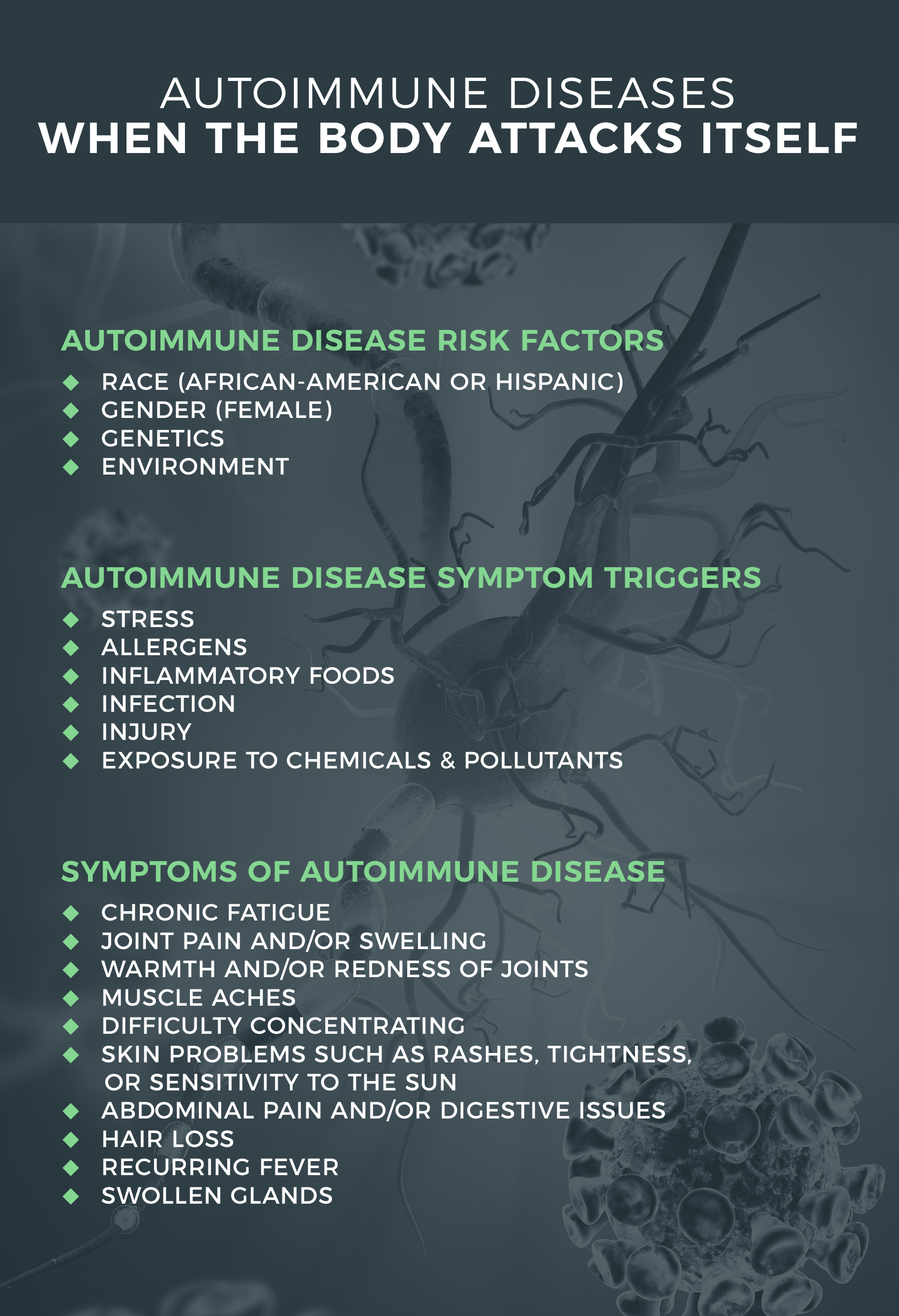Autoimmune Diseases: When the Body Attacks Itself
 By: by Amino Science
By: by Amino Science

Autoimmune diseases are relatively common in the United States. The American Autoimmune Related Diseases Association reports that 50 million Americans have some form of autoimmune disease. Of those 50 million Americans, 75% are women.
Let’s answer some of the most common autoimmune-related questions:
- What exactly is an autoimmune disease?
- What are the most common autoimmune diseases?
- Why do autoimmune diseases affect women so much more frequently than men?
What Is Autoimmune Disease?
Autoimmune disease does not refer to one particular disease but rather a group of diseases, or autoimmune disorders, that all stem from the body’s immune system misfiring or malfunctioning.
The body’s immune system is comprised of white blood cells that produce antibodies. These antibodies are the body’s defense system against everything from common colds and sinus infections to shingles, pneumonia, and cancer. The immune system’s job is to produce these white blood cells and antibodies so they can protect the body from illness and help it heal from injury.
But sometimes, the immune system confuses healthy cells and tissue for foreign cells and germs. When this happens, the immune system produces autoantibodies that may attack the body’s own tissues, organs, cells, joints, and muscles, although the body's connective tissues (skin, muscle, and joints) are the most vulnerable to attack. So, a simple definition of an autoimmune disorder is a disease in which the immune system attacks the body.
Autoimmune diseases take many forms. They are often systemic, meaning they attack numerous parts of the body. An example is rheumatoid arthritis, which attacks multiple joints and the surrounding tissue. An autoimmune disease may also focus on one main part of the body, such as Graves’ disease, which attacks the thyroid. Autoimmune diseases may develop at any age but often start at a young age or in middle age.
What Causes Autoimmune Diseases?
Doctors know that autoimmune diseases are brought on by the body’s immune system misfiring and launching missiles at healthy cells. But they do not know what causes this autoimmune response to begin. Several risk factors are thought to contribute to one’s risk for developing an autoimmune condition.
Race
Some autoimmune diseases, such as lupus, are more frequently diagnosed in Hispanic and African-American people. Overall, African American, Latino, and American Indian ethnic groups tend to be at a higher risk for autoimmune conditions.
Genetics
Autoimmune diseases do have a hereditary link. Often, several members of the same family are found to have an autoimmune disease, even though they may not all have the same disease. For example, it is possible for three different members of the same family to each have an autoimmune disease for a total of three different autoimmune diseases in one family. Each of the three family members would likely have something written in his or her genetic code that made them develop an autoimmune disease, even though the autoimmune response may manifest as a different disease in each person.
Environmental Factors
Some doctors believe that environment plays a critical role in the onset of autoimmune diseases. A 2016 study published in Cellular and Molecular Life Sciences and a 2004 study published in the European Journal of Endocrinology highlighted key environmental factors such as diet, smoking, radiation exposure, and bacterial or viral infections that are thought to contribute to the development of certain autoimmune diseases, including thyroid diseases and multiple sclerosis.
Some people may develop more than one autoimmune disease. A study published in Maedica A Journal of Clinical Medicine revealed that about 25% of autoimmune patients tend to have one or more additional autoimmune diseases. If a patient develops three or more autoimmune diseases, it is known as multiple autoimmune syndrome, or MAS.

Symptom Triggers
Regardless of the genetic or environmental factors that may cause a person to develop an autoimmune disease, there are certain triggers that may bring about the initial onset of symptoms. These triggers may also induce a flare of symptoms, even if the disease has been in a state of remission for some time. Common triggers of autoimmune activity and symptoms include:
- Stress—thought by some to be the number one cause of symptom flares
- Allergens
- A diet high in inflammatory foods like sugar, sodium, and alcohol
- Infection
- Injury
- Environmental factors such as exposure to chemicals
Women vs. Men
For years, doctors and scientists have been trying to figure out why autoimmune diseases are more prevalent in women than in men. While no one knows the exact reason, various studies lean toward a genetic predisposition and environmental factors.
A study published in the journal Emerging Infectious Diseases suggests that infections may play a role, as women have been shown to have an increased immune response over men when it comes to severe infection. Researchers believe that when women face a serious infection or illness the elevated response from their immune systems may be a triggering factor in the development of autoimmune diseases, though further research is needed to confirm this.
Other studies suggest a link between autoimmune diseases and sex chromosomes. A 2015 study published in Frontiers in Genetics suggests that, because women have two X chromosomes while men have only one X and one Y chromosome, the additional X chromosome in women may play a part as to why women develop autoimmune diseases more frequently than men do.
Despite many studies and theories as to why autoimmune diseases develop more often in women than in men, the short answer is that no one quite knows for sure yet.
Symptoms of Autoimmune Disease
According to the American Autoimmune Related Diseases Association, there are over 100 different types of autoimmune diseases. Many autoimmune diseases present with similar symptoms.
More specific symptoms will be found when looking into different diseases. For example, lupus may present with a butterfly-shaped rash across the face and joint pain, and Graves’ disease may present with unexplained weight loss and a goiter, or enlarged thyroid, that can be seen and felt when swallowing. Psoriasis shows up as scaly, silvery plaques on the skin due to the immune system's overproduction of T-cells.
With some diseases, a patient may experience periods of remission, in which the symptoms go away. When the symptoms return, the patient is considered to be having an active flare.
Diagnosing Autoimmune Diseases
Diagnosing an autoimmune disease can be very difficult. Many autoimmune diseases present with similar symptoms and most do not have a single definitive test that will provide a simple positive or negative result. The American Autoimmune Related Diseases Association states that the average autoimmune patient spends over 3 years seeking a correct diagnosis and will see 4 different doctors during that time.
Diagnosing an autoimmune disease often consists of running a variety of tests and ruling out certain conditions to try to narrow things down. If a doctor suspects a patient’s symptoms are from an autoimmune disease, he or she will typically order a series of blood tests. Common blood tests used for diagnosing autoimmune diseases include:
- Antinuclear antibody test (ANA): An ANA test is a blood test that checks for autoantibodies. If a patient has a positive ANA test, it doesn’t necessarily mean he or she has an autoimmune disease, but it does let the doctor know that an autoimmune disease shouldn’t be ruled out.
- Inflammation test: Some autoimmune diseases, such as rheumatoid arthritis, cause chronic inflammation throughout the body. If a patient’s inflammatory markers are high, it helps point the doctor toward an inflammatory disease.
- Organ function tests: Some autoimmune diseases, such as Graves’ disease or lupus, target specific organs like the thyroid or kidneys. So most health care providers want to see how well a patient’s organs are functioning. If there is any indication that a specific organ is not working properly, then the doctor may be able to narrow down the list of possible diseases.
In addition to blood tests, a doctor may order images such as X-rays, sonograms, or MRIs. X-rays and sonograms may be able to show damage from a condition like rheumatoid arthritis. MRIs can be useful in diagnosing multiple sclerosis, as the disease typically causes lesions on the brain and spinal cord. A colonoscopy may be used to diagnose or rule out inflammatory bowel diseases such as ulcerative colitis and Crohn’s disease.
Types of Autoimmune Disease
The American Autoimmune Related Diseases Association lists over 100 different autoimmune diseases. Here are just a few of the most common.
- Rheumatoid arthritis
- Systemic lupus erythematosus
- Celiac disease
- Pernicious anemia
- Psoriasis and psoriatic arthritis
- Inflammatory bowel disease
- Hashimoto's disease
- Autoimmune Addison's disease
- Sjogren's disease
- Type 1 diabetes
- Graves' disease
- Guillain-Barre syndrome
- Autoimmune hepatitis
- Myasthenia gravis
- Multiple sclerosis

Autoimmune Diseases Treatment
Treating autoimmune diseases can be a tricky business as not all patients will respond to the same treatments and some autoimmune diseases may be more aggressive in some patients than in others. The type of treatment a doctor recommends will depend upon the type of autoimmune disease he or she thinks is present. Treatments usually consist of a variety of medications including:
- Pain relievers
- Anti-inflammatories
- Immunosuppressant drugs
From there it gets more specific. For instance, type 1 diabetes patients require insulin injections to regulate blood sugar, and people with underactive thyroid are prescribed thyroid hormone replacement to restore thyroid hormone levels.
In some cases, surgery may be required depending upon the disease, its impact on the body, and the overall health of the patient. For example, sometimes lupus patients will need to undergo a kidney transplant or Graves’ disease patients may need a partial or total thyroidectomy. These are usually done in cases in which the disease was caught in a late stage and much damage had already occurred or the patient did not respond well to medications and treatments and so the disease continued to progress and cause damage.
Depending upon the disease, some patients may also find relief in alternative therapies such as:
- Acupuncture
- Reiki
- Massage therapy
- Chiropractic care
- Meditation and mindfulness
Nutrition also comes into play. Amino acid supplementation proves useful for various autoimmune conditions because amino acids help promote healthy inflammation levels.
Any treatment plan should first be discussed with a physician to ensure it is safe for the particular autoimmune disease that has been diagnosed. Most autoimmune diseases are chronic and last a lifetime. While patients can achieve periods of remission, autoimmune diseases are unpredictable and can flare up at any time.

Up to 25% off Amino
Shop NowTAGS: conditions
Join the Community
Comments (0)
Most Craveable Recipes




 833-264-6620
833-264-6620



















